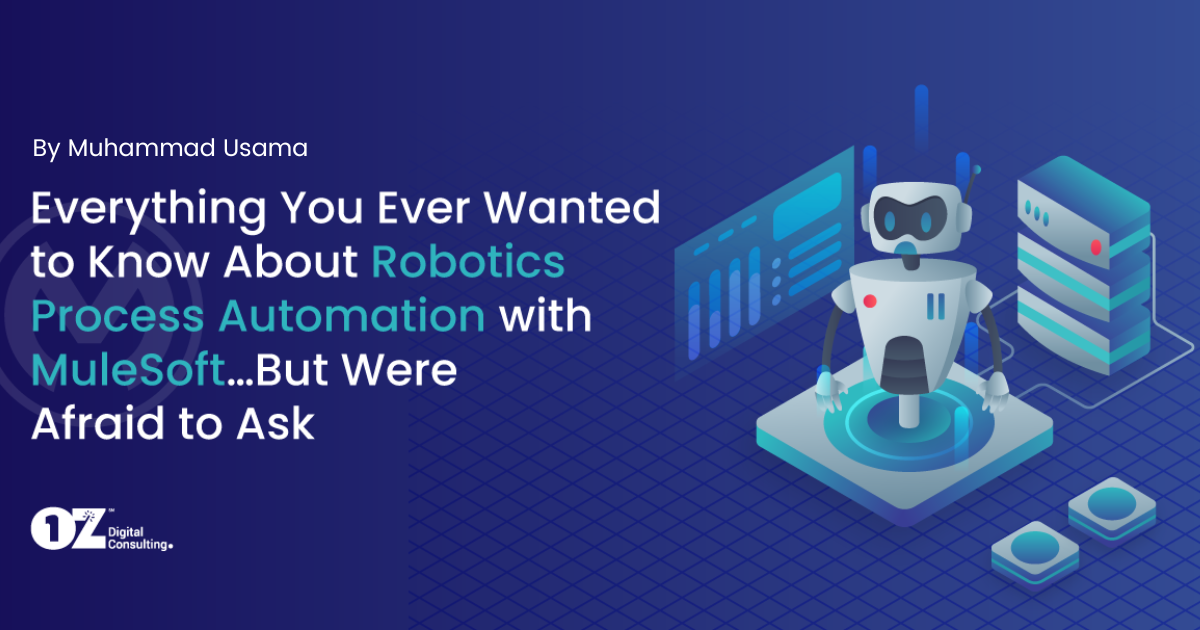By Muhammad Usama, Mulesoft-Certified Developer & Automation Consultant
Every company wants to increase its employee productivity and digital competitiveness in the market. Unfortunately, most standard workflows, rife with time-consuming manual tasks, stand in the way.
How can we bridge that gap?
Enter Robotic Process Automation (RPA), which automates repetitive tasks with bots, mimicking human users as it interacts with applications, extracts data, and sends emails—increasing productivity (especially on higher-value tasks) while reducing costs and user error.
Use Cases for RPA
In banking, insurance, and healthcare industries, RPA can be an essential component of…
- improving customer and employee productivity while reducing costs.
- streamlining customer onboarding.
- automating data extraction, data entry, and processing across applications, documents, and images.
- improving the accuracy and compliance within processes.
Contrary to popular thought, RPA and APIs are not siloed competitors: APIs are software interfaces, providing a service to different software and allowing systems and datasets to be integrated. RPA, meanwhile, automates tasks with the help of intelligent bots that scrape the data from one system to another. This is to say, there are situations where an API-led approach works with RPA as a mechanism to broaden the scope of integration and enable access to more endpoints.
RPA may help implement business scenarios where process automation using an API-led method is not yet feasible.
Some examples are when…
- a system lacks an API, such as a legacy program, on-premises application, or system significantly customized for the company.
- an API for an endpoint is either delayed or not created at all, creating a situation in which RPA may be used as a workaround to gain access to the system.
- automation and integration are managed by various teams.
RPA in MuleSoft
Powerhouse API/integration platform and OZ partner MuleSoft has introduced MuleSoft RPA, which makes it simple for line-of-business and knowledge workers to automate business operations and boost productivity.
With the additional robotic process automation (RPA) capabilities in recent workflows, repetitive tasks have now been replaced by intelligent bots that can process documents, enter data, or act on behalf of users all without writing any line of code. As a part of MuleSoft’s leading unified platform, MuleSoft RPA allows these bots to function with any system or application, including PDF files, spreadsheets, and even legacy systems.
API management and RPA capabilities may now be combined with hyper-scale resilience, global governance, end-to-end security, and reuse at scale by customers who can group into a composable business by combining best-in-class integration, API management, and RPA capabilities.
MuleSoft RPA offers the following applications:
- RPA Manager is used for automation, and it is integrated into the Anypoint Platform. It manages user access and permission and manages deployed automation.
- RPA Builder is an application that enables you to build automation by specifying the logic of the process and helps to run local tests.
- RPA Recorder is a tool that records the user actions during the building phase of a process by automatically recording.
- RPA bots are software robots that execute automation and can read text and images. RPA bot also can manage bots from RPA Manager.
Onward to the Future
From maximizing current technology assets to integrating new technologies, RPA can prove critical to ensuring your hardware, software, and human resources are optimized and effective.
Ready to get started?
Let OZ place our experts and quarter-century of experience at your disposal—reach out today!



